Data structure and algorithm learning notes (7) tree
Previous review
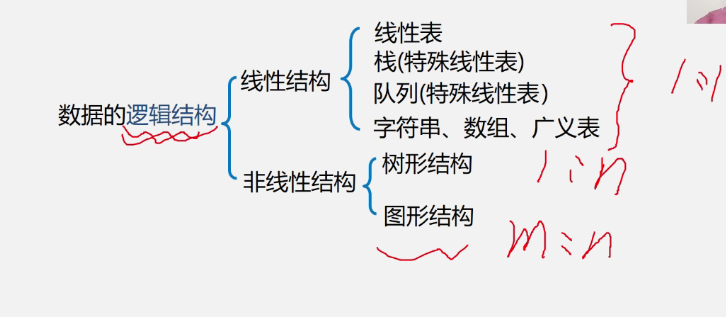
1, Definition of tree and binary tree
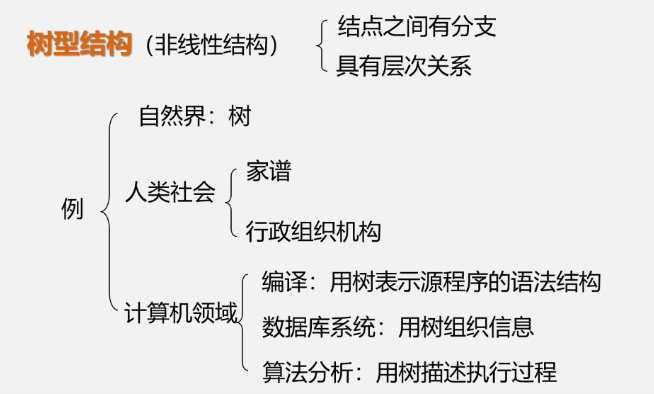
1. Trees
Definition of tree
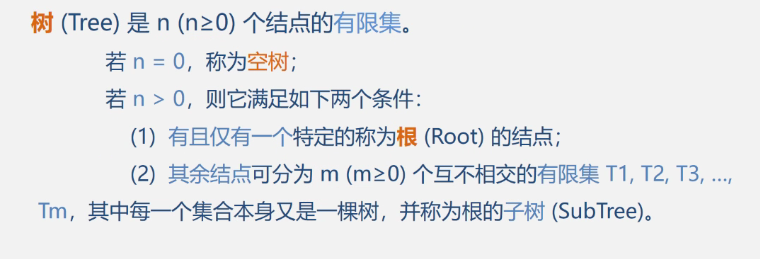
Recursive nested definition
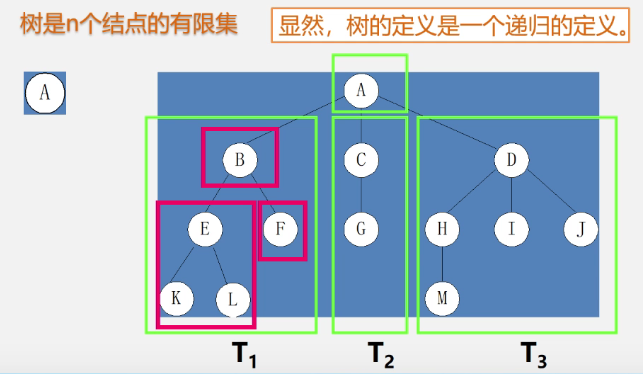
-
Other representations of trees
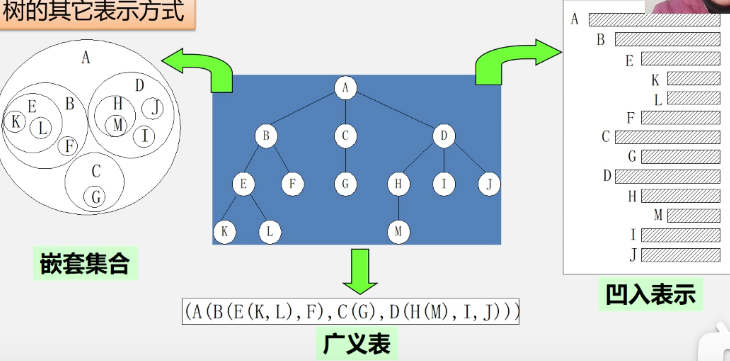
It's a bit like this markdown syntax:
- A
- B
- E
- K
- L
- F
- E
- C
- G
- D
- H
- M
- I
- J
- H
Basic terms of trees

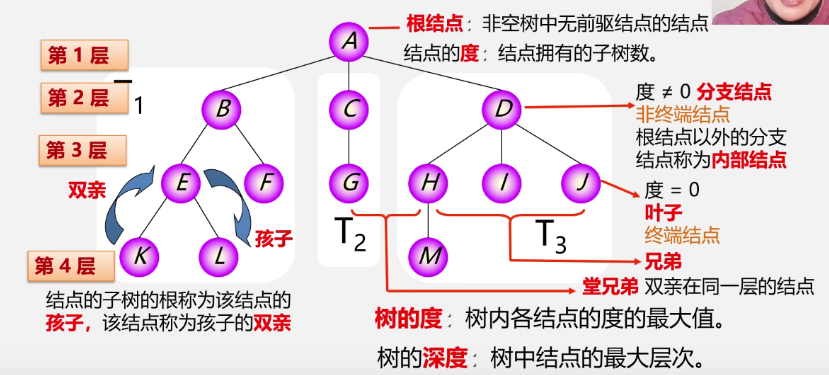
The degree of a node is also the number of branches and the number of successors
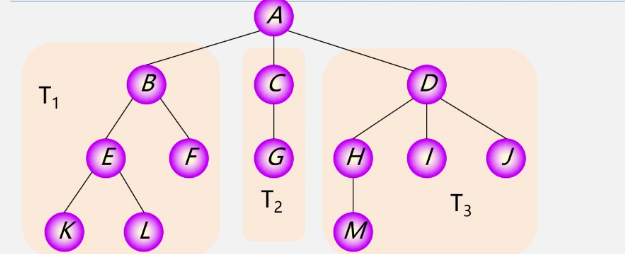
-
Ordered tree: the subtrees of nodes in the tree are ordered from left to right (the leftmost is the first child)
-
Unordered tree: the subtrees of the nodes in the tree have no order
-
Forest: a collection of m(m ≥ 0) disjoint trees
Tree to forest:
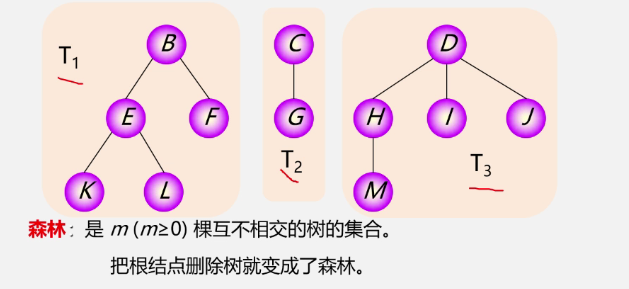
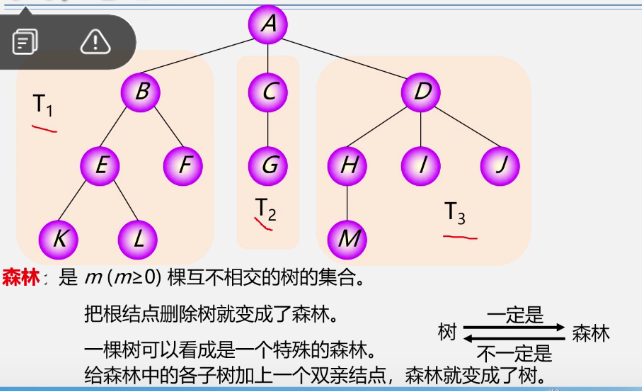
-
Comparison between tree structure and linear structure
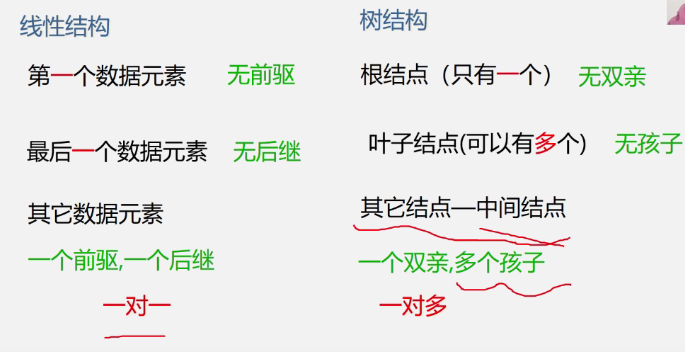
2. Binary tree
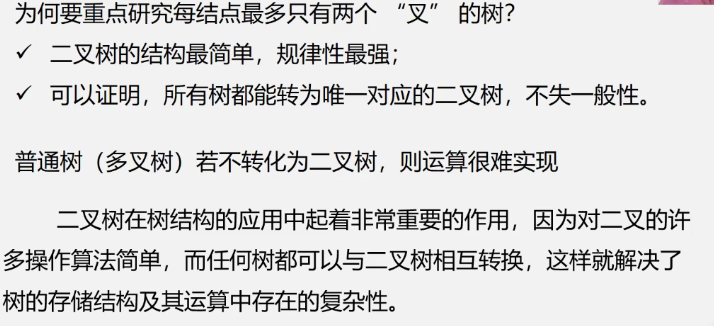
Definition of binary tree
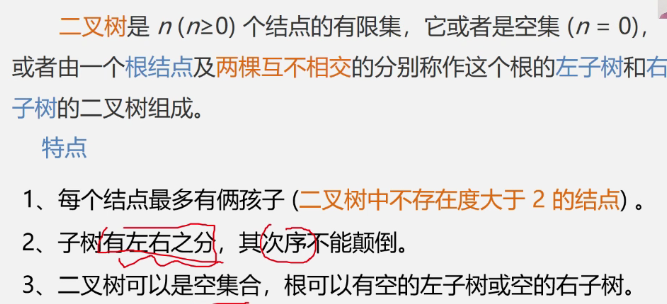
The difference between binary tree and tree
Binary tree and tree are two concepts. Binary tree is not a special case of tree
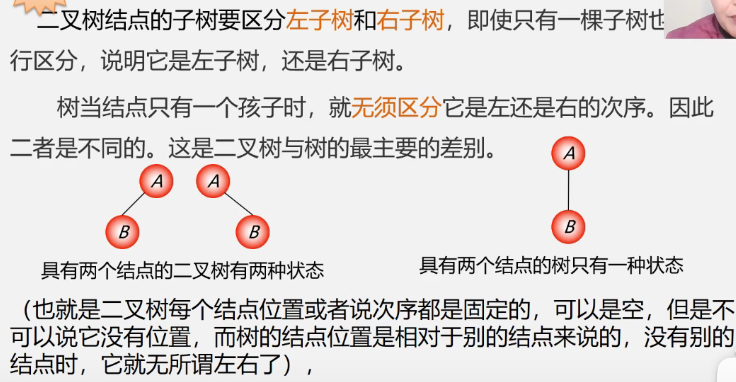
-
example
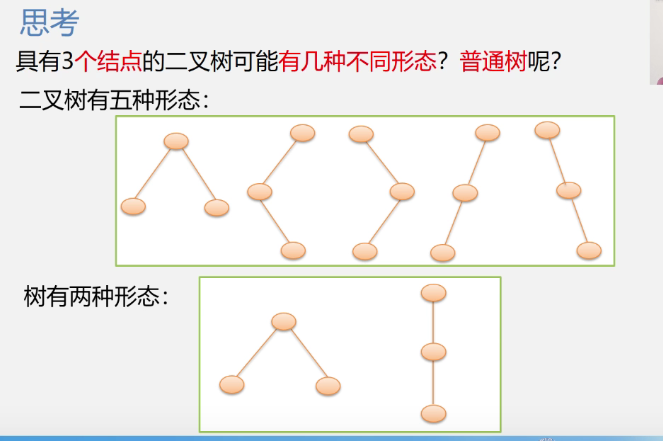
-
Although they are two concepts, the basic terms related to trees are applicable to binary trees
Basic form of binary tree
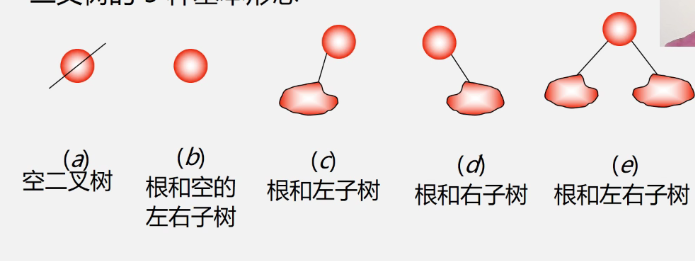
3. Abstract data type definition of tree and binary tree
Tree:
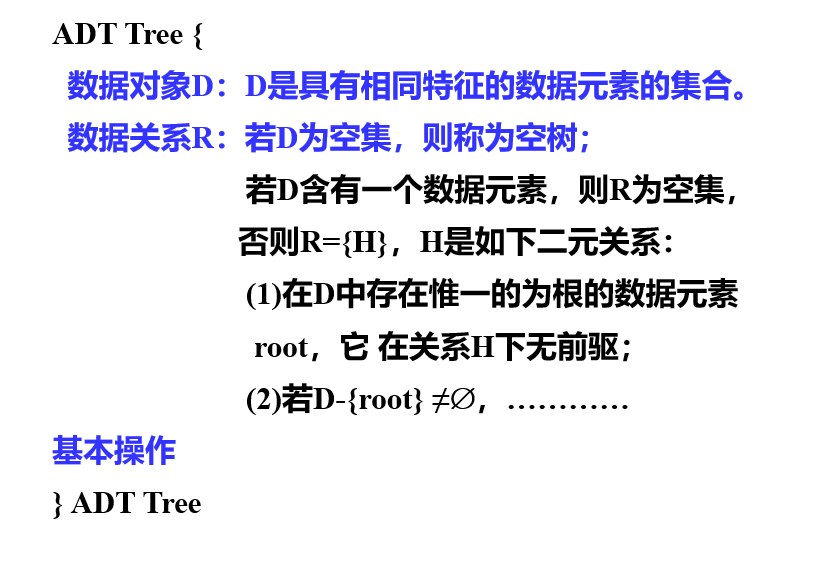
-
Mainly learn the abstract data type definition of binary tree
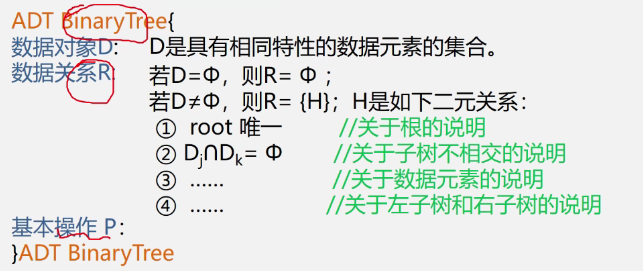
-
There are many basic operations. The following are the main ones:
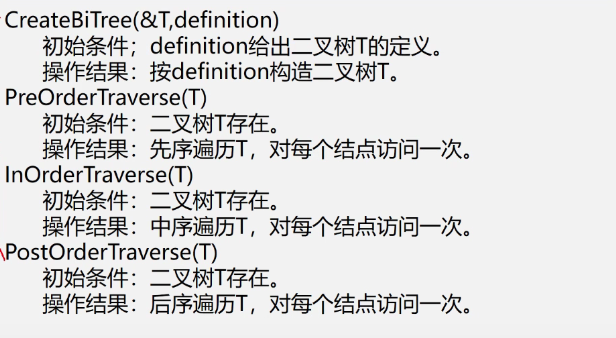
-
2, Properties and storage structure of binary tree
1. Properties of binary tree
① Binary tree properties 1, 2, 3
-
Number of nodes per layer

- There is at least one node on layer i
-
Total number of nodes

-
Relationship between the number of leaves and the number of nodes with degree 2
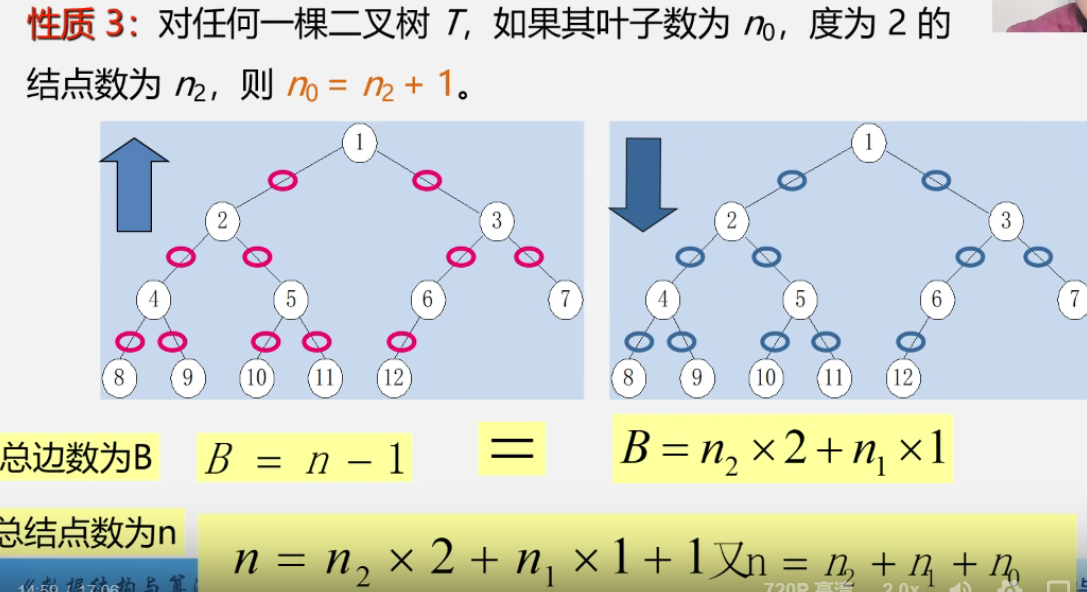
n represents the total number of nodes
n 1 n_1 n1 represents a node with a degree of 1
- 🤩 Top down and then bottom up thinking
② Two special forms of binary trees: full binary tree and complete binary tree

Definition and characteristics
- Full binary tree
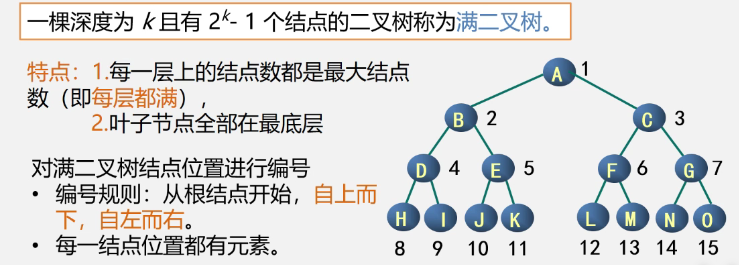

-
Complete binary tree
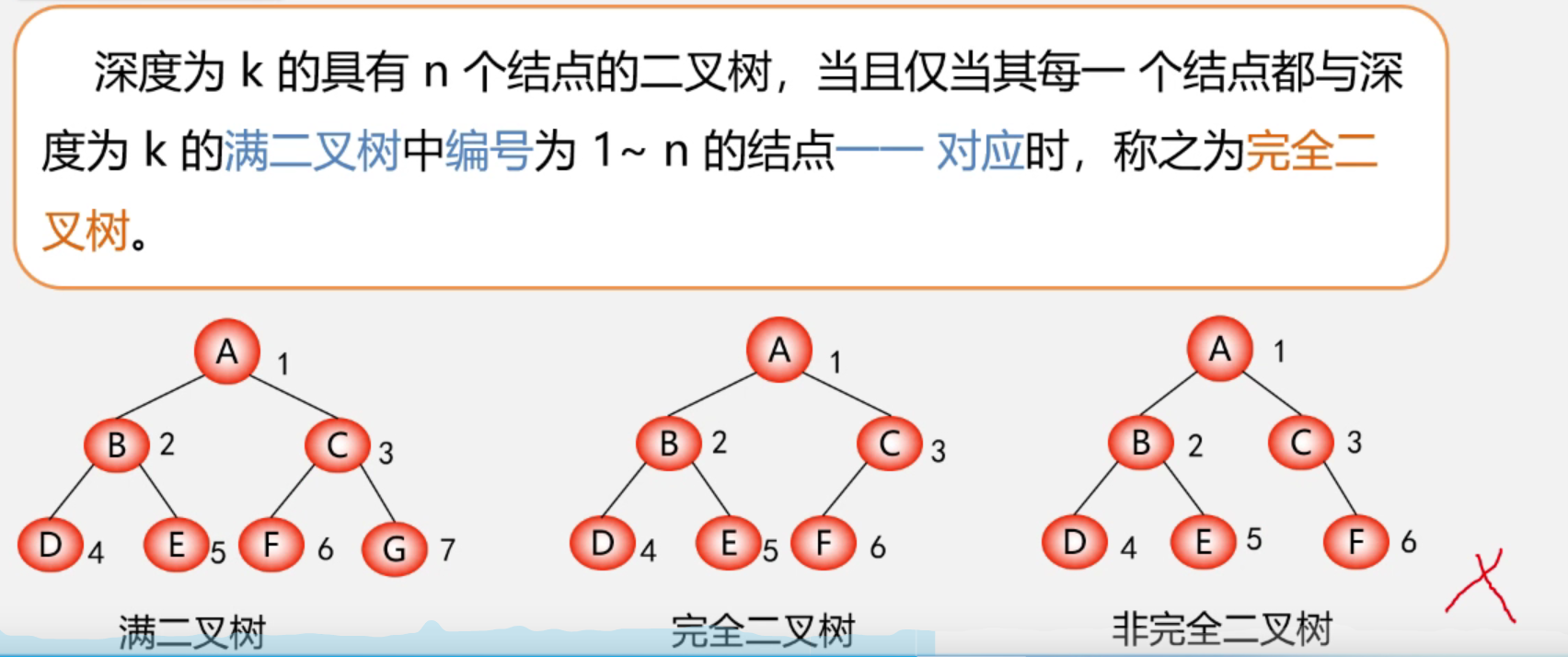
-
Judgment skills
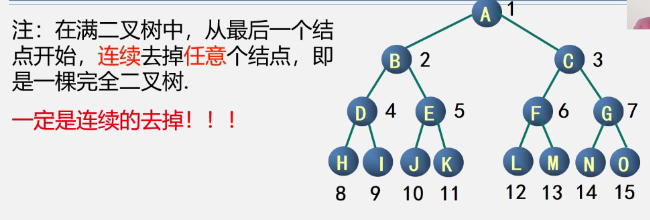
-
characteristic
[external chain picture transfer failed. The source station may have an anti-theft chain mechanism. It is recommended to save the picture and upload it directly (img-qtpivbor-1637761025234)( https://cdn.jsdelivr.net/gh/xin007-kong/picture_new/img/20210928093038.png )]
-
Relationship between the two
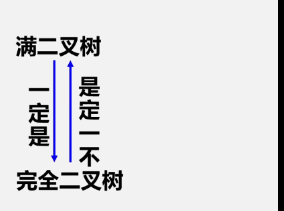
③ Properties 4 and 5 of binary tree (two properties of complete binary tree)
- Property 4: depth of complete binary tree
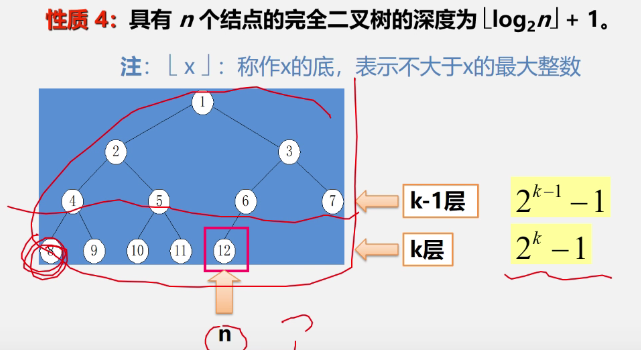
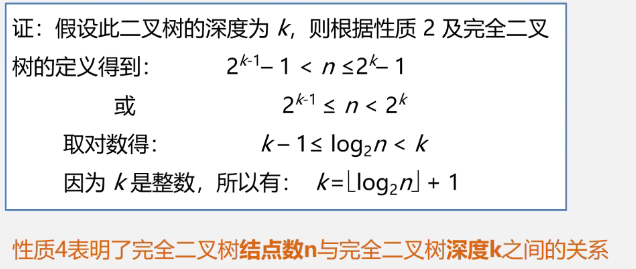
-
Property 5: relationship between node numbers
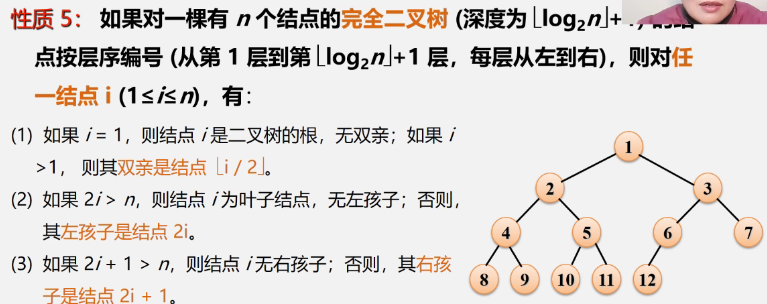
-
Property 5 shows the relationship between parent node numbers and child node numbers in a complete binary tree
Proof: mathematical induction
-
Judge complete binary tree: with the help of queue
2. Storage structure of binary tree
[external link picture transfer failed. The source station may have anti-theft chain mechanism. It is recommended to save the picture and upload it directly (img-lwsp7ijn-1637761025237)( https://cdn.jsdelivr.net/gh/xin007-kong/picture_new/img/20211005081221.png )]
① Sequential storage
-
Implementation: according to the node level number of the full binary tree, the data elements in the binary tree are stored in turn
-
For example:

First from top to bottom, then from left to right
-
type definition
#define MAXTSIZE 100 typedef TElemType SqBiTree[MAXTSIZE]; SqBiTree bt;
The above SqBiTree is a data type, and the defined variable type is texttype [maxsize]
That is, the bt above is an array of texttype with maxsize elements
-
Look at an example

-
Characteristics of binary tree sequential storage


② Chain storage
Binary linked list
-
Characteristics of binary tree nodes
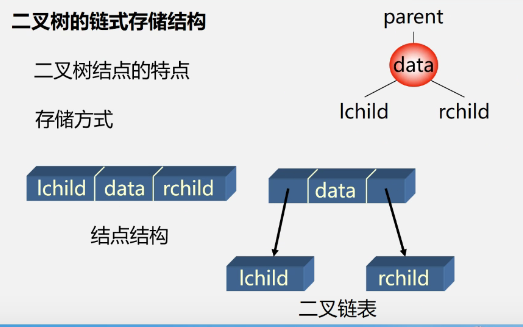
-
Storage structure definition
typedef struct BiNode{ TElemType data; struct BiNode *lchild,*rchild; //Left and right child pointers }BiNode,*BiTree;- Look at an example
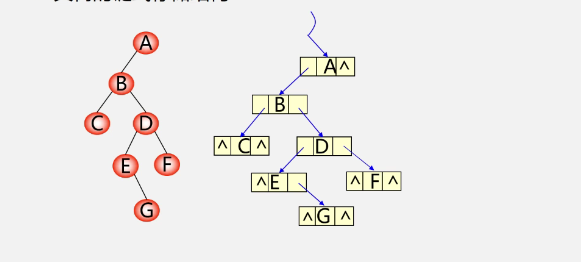
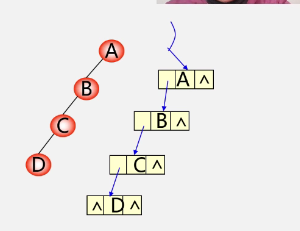
-
Number of empty finger fields
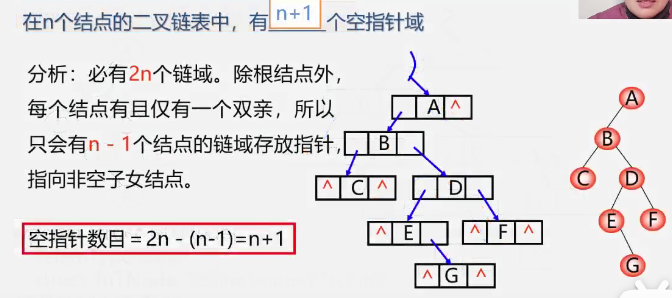
- Each node has a connection to its parents, except the root node
- Therefore, only the chain domain of n-1 nodes will store pointers to non empty child nodes
- Each node has a connection to its parents, except the root node
Trigeminal linked list
-
Sometimes you need to find a precursor
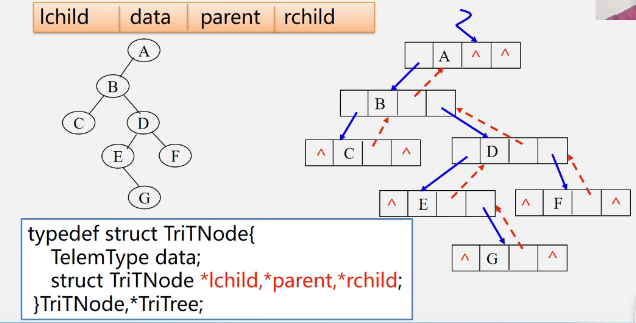
3, Traversing binary tree and clue binary tree
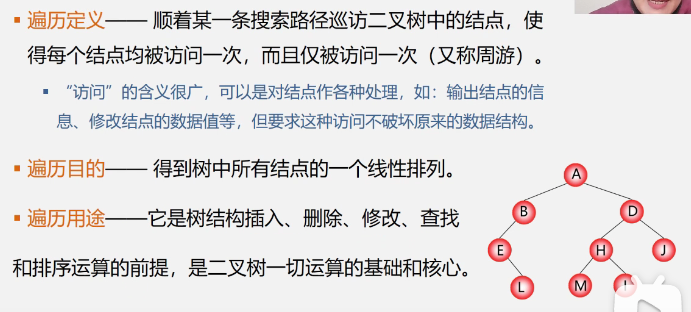
1. Overview of traversal method
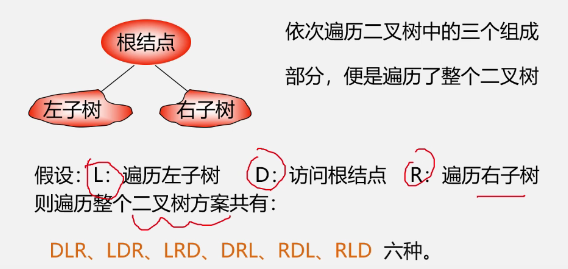
-
Focus on DLR, LDR and LRD
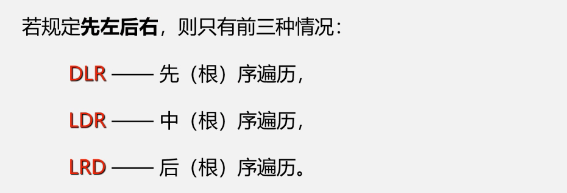
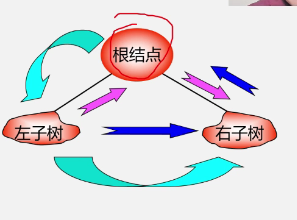

According to the recursive definition of binary tree, traversing left subtree and right subtree can be "recursive" as traversing binary tree
Operation definition of preordered traversal of binary tree
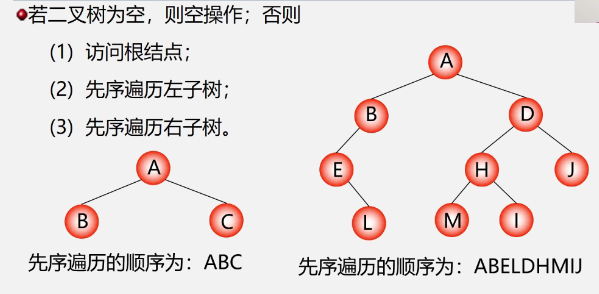
Operation definition of traversing binary tree in middle order
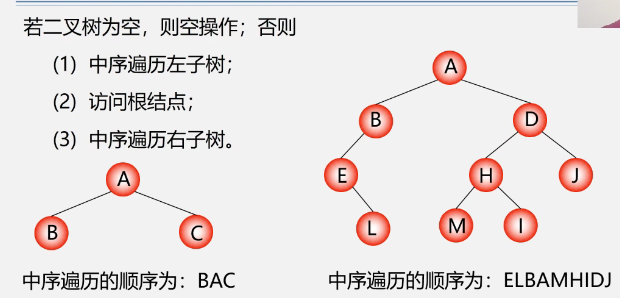
Operation definition of post order traversal of binary tree
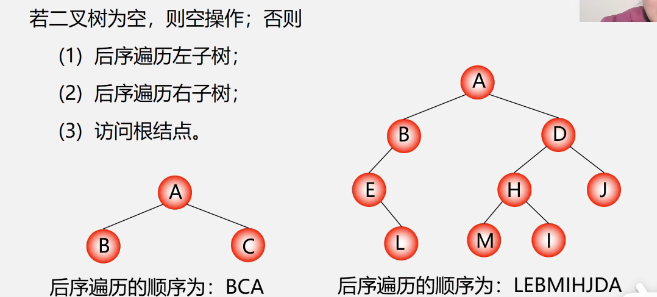
example
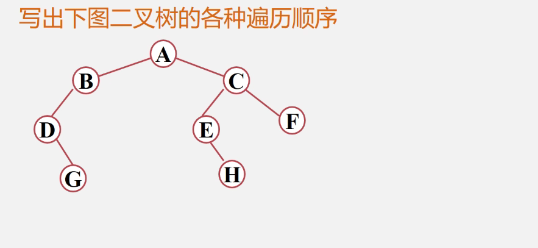
- Preamble: ABDGCEHF
- Middle order: DGBAEHCF
- Later: GDBHEFCA
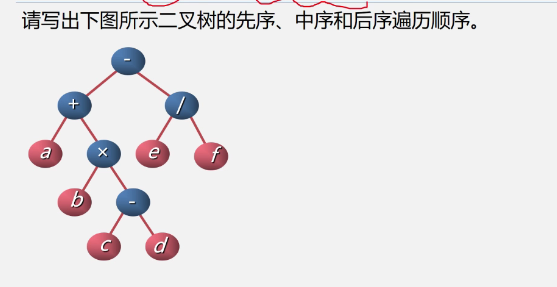
-
Precedence: - + a × b-cd/ef
-
Middle order: a+b × c-d-e/f
-
Later: abcd- ×+ ef/-
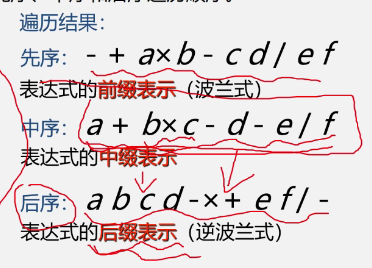
2. Determine the binary tree according to the traversal sequence
-
If the values of each node in the binary tree are different, the pre order sequence, middle order sequence and post order sequence of binary tree nodes are unique
-
The unique binary tree can be determined by the pre order sequence and middle order sequence of the binary tree, or by the post order sequence and middle order sequence of the binary tree
-
example
[the external chain picture transfer fails. The source station may have an anti-theft chain mechanism. It is recommended to save the picture and upload it directly (IMG hgendyck-163776102558)( https://cdn.jsdelivr.net/gh/xin007-kong/picture_new/img/20211005094048.png )]


-
example
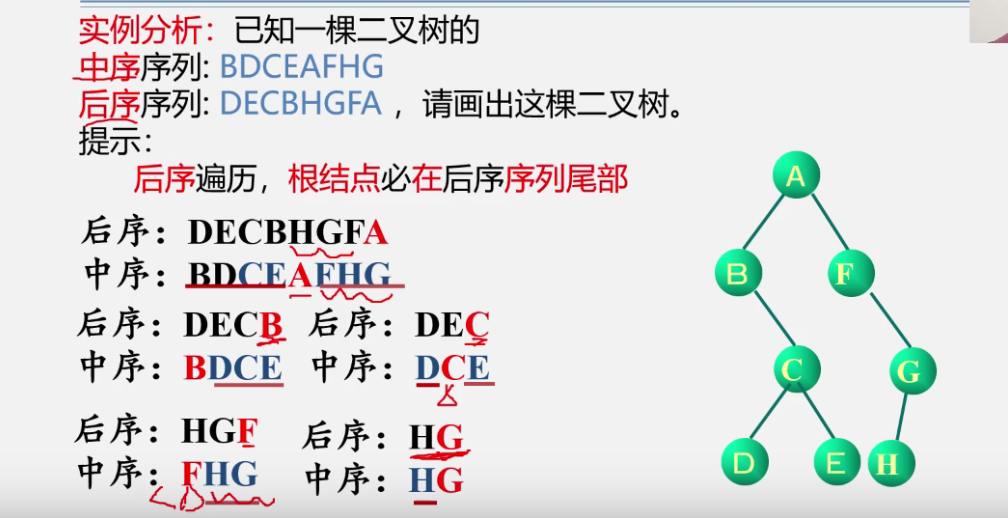
-
3. Implementation of traversal method of binary tree
Preorder traversal recursive algorithm
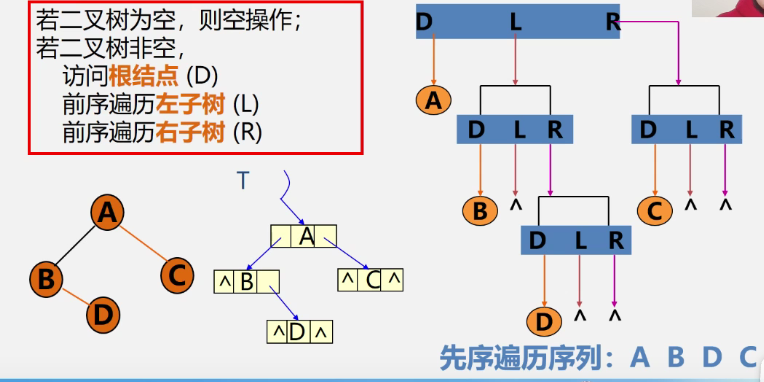
Status PreOrderTraverse(BiTree T){
if(T==NULL) return OK; //Empty binary tree
else{
visit(T); //Access root node
PreOrderTraverse(T->lchild); //Recursive traversal of left subtree
PreOrderTraverse(T->rchild); //Recursive traversal of right subtree
}
}
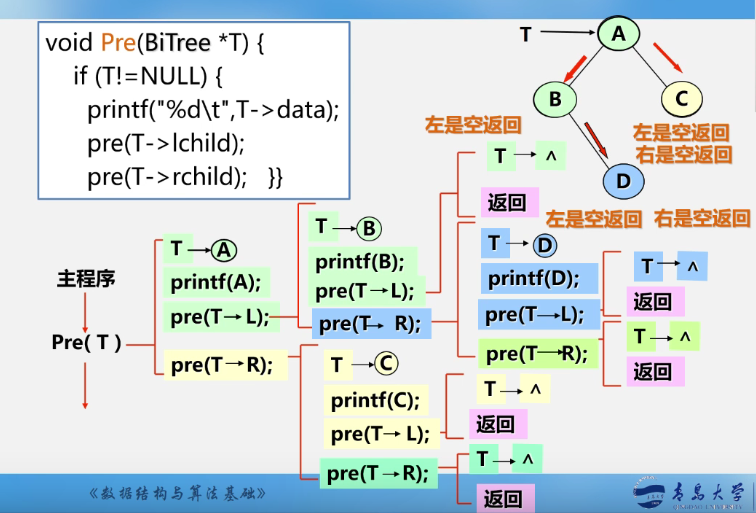
-
Preorder sequence
ABDC
Middle order traversal recursive algorithm
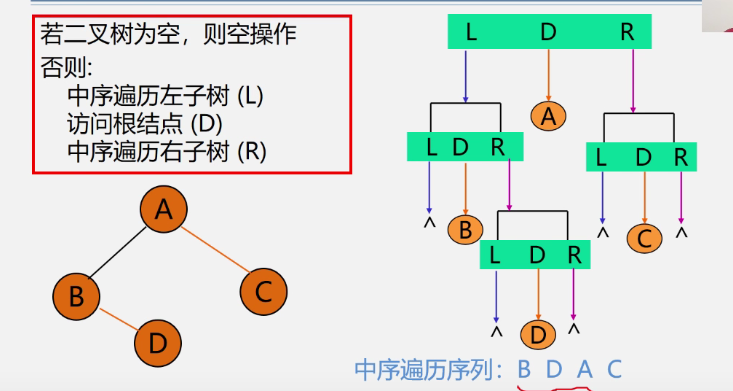
Status InOrderTraverse(BiTree T){
if(T==NULL) return OK; //Empty binary tree
else{
InOrderTraverse(T->lchild); //Recursive traversal of left subtree
visit(T); //Access root node
InOrderTraverse(T-rchild); //Recursive traversal of right subtree
}
}
Postorder traversal recursive algorithm
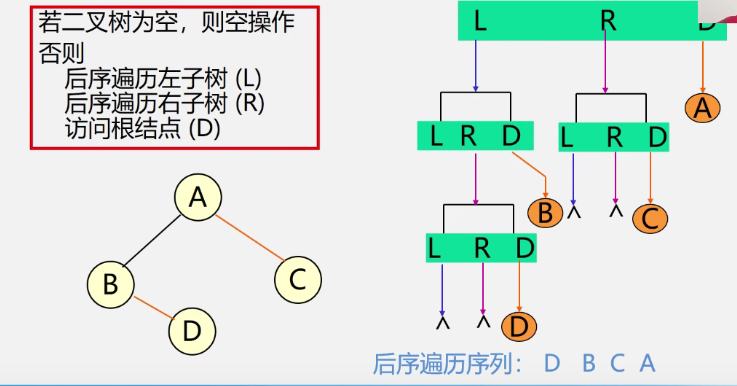
Status PostOrderTraverse(BiTree T){
if(T==NULL) return OK; //Empty binary tree
else{
PostOrderTraverse(T->lchild); //Recursive traversal of left subtree
PostOrderTraverse(T-rchild); //Recursive traversal of right subtree
visit(T); //Access root node
}
}
Comparative analysis of three recursive traversal algorithms
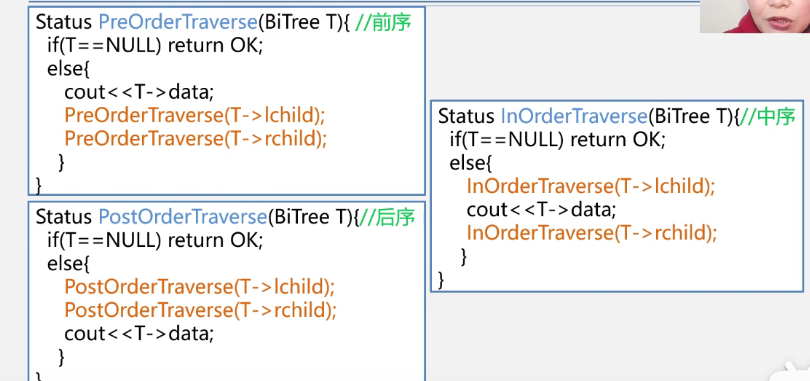

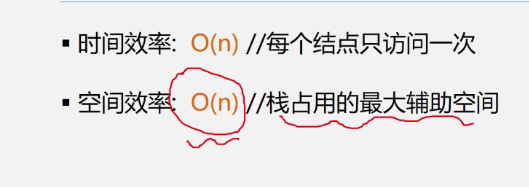
Space is stack
Middle order traversal non recursive algorithm
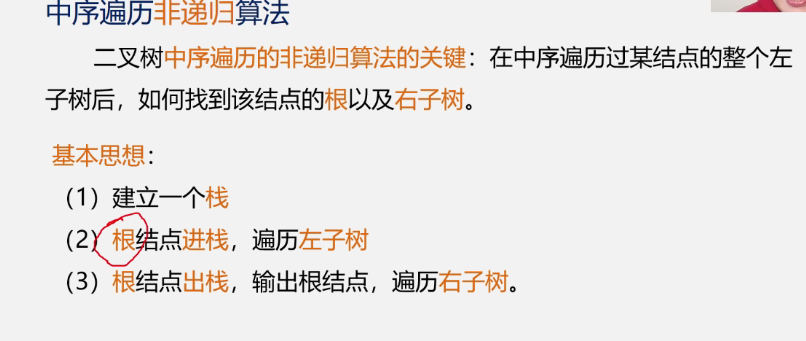
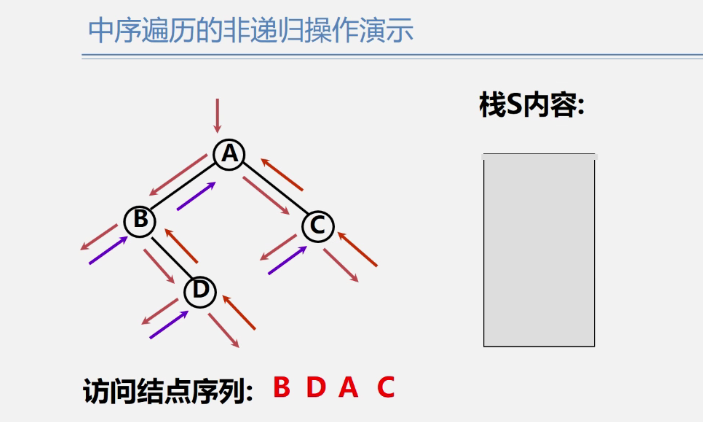
Status InOrderTraverse(BiTree T){
BiTree p;
InitStack(S);
p=T; //Point to root node
while(p||!StackEmpty(S)){
if(p){
Push(S,p);
p=p->child;
}
else{
Pop(S,p);
printf("%c",q->data);
p=q->child;
}
return OK;
}
}
Hierarchical traversal algorithm of binary tree
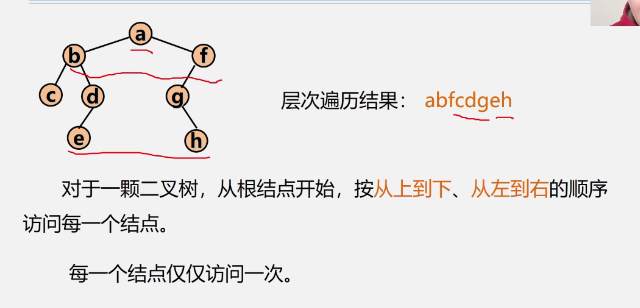
-
Algorithm idea
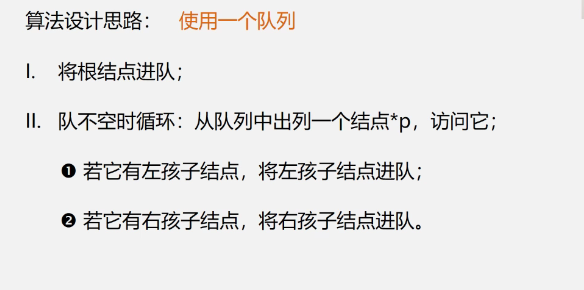
-
Algorithm description
Use sequential loop queue
Queue types are defined as follows:
typedef struct{ BTNode data[MaxSize]; //Store elements in the queue int front, rear; //Head and tail pointer }SqQueue; //Sequential loop queue typeBinary tree hierarchy traversal algorithm:
void LevelOrder(BTNode *b){ BTNode *p; SqQueue *qu; //Initialize queue enQueue(qu,b); //The root node pointer enters the queue while(!QueueEmpty(qu)){ //Loop if the queue is not empty deQueue(qu,p); //Outgoing node p printf("%c",p->data); //Access node p if(p->lchild!=NULL) enQueue(qu,p->lchild); //When there are left children, let them join the team if(p->rchild!=NULL) enQueue(qu,p->rchild); //When there are right children, let them join the team } }
4. Application of binary tree traversal algorithm
Algorithm for establishing binary tree
The binary linked list of binary tree is established by traversing the sequence in advance
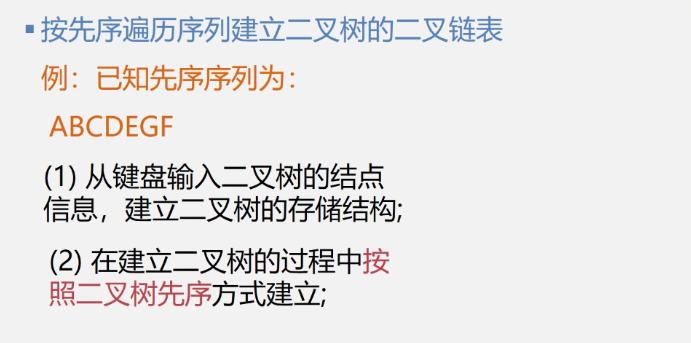
The tree established according to a pre sequence is not unique, such as:
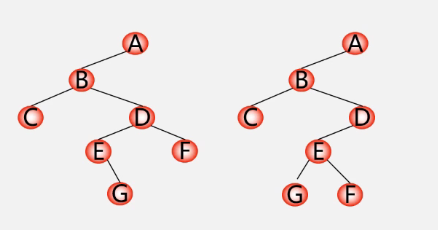
To avoid duplication, you can add empty nodes and use # instead

-
Algorithm description
Status CreateBiTree(BiTree &T){ scanf(&ch); if(ch=="#") T=NULL; else{ if(!(T=(BiTNode*)malloc(sizeof(BiTNode)))) { //T=new BiTNode; exit(OVERFLOW); } T->data = ch; //Generate root node CreateBiTree(T->lchild); //Construct left subtree CreateBiTree(T->rchild); //Construct right subtree } return OK; }
Duplicate binary tree
-
Algorithm idea

-
Algorithm description
int Copy(BiTree T, BiTree &NewT){ if(T==NULL){ //If it is an empty tree, return 0 NewT=NULL; return 0; } else{ NewT=new BiTNode; NewT->data=T->data; Copy(T->lChild,NewT->lchild); Copy(T->rchild,NewT->rchild); } }
Calculate the depth of the binary tree
-
Algorithmic thought

-
Algorithm description
int Depth(BiTree T){ if(T==NULL) return 0; else{ m=Depth(T->lchild); n=Depth(T->rchild); if(m>n) return (m+1); else return (n+1); } }
Calculate the total number of binary tree nodes
-
Algorithmic thought

Plus 1 is the root node
-
Algorithm description
int NodeCount(BiTree T){ if(T==NULL) return 0; else return NodeCount(T->lchild)+NodeCount(T->rchild)+1; }
Calculate the number of leaf nodes of binary tree
-
Algorithmic thought

-
Algorithm description
int LeafCount(BiTree T){ if(T==NULL) //If it is an empty tree, return 0 return 0; if(T->lchild == NULL && T->rchild == NULL) return 1; //If it is a leaf node, return 1 else return LeafCount(T->lchild) + LeafCount(T->rchild); }
5. Clue binary tree
-
why
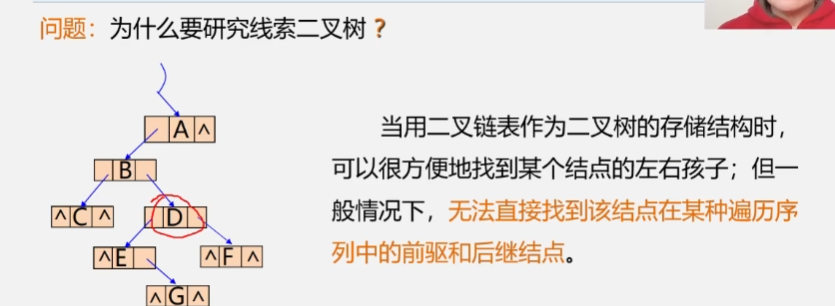
-
Possible solutions
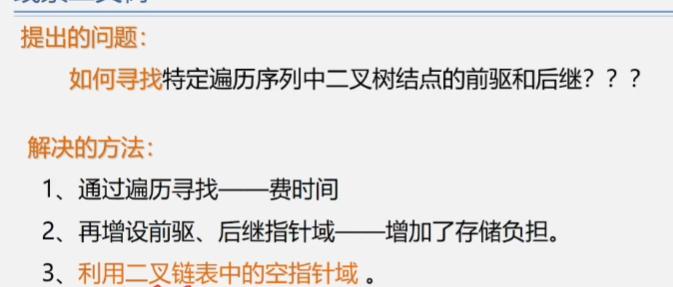
-
Review the empty finger field
[external chain picture transfer failed. The source station may have anti-theft chain mechanism. It is recommended to save the picture and upload it directly (img-lofyc38f-163776102579)( https://cdn.jsdelivr.net/gh/xin007-kong/picture_new/img/20211008083920.png )]
-
Empty finger needle field using binary linked list
-
-
what

-
The process of turning a binary tree into a clue binary tree in a certain ergodic order is called cueing
-
example
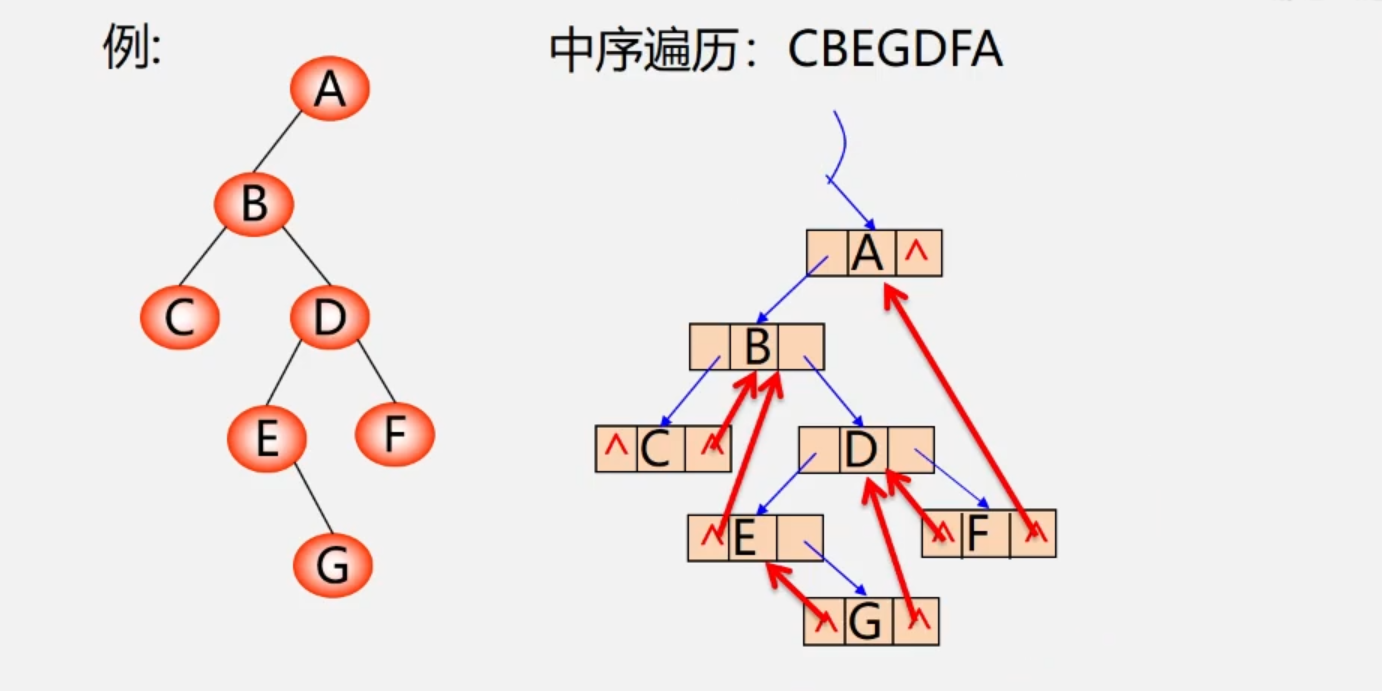
-
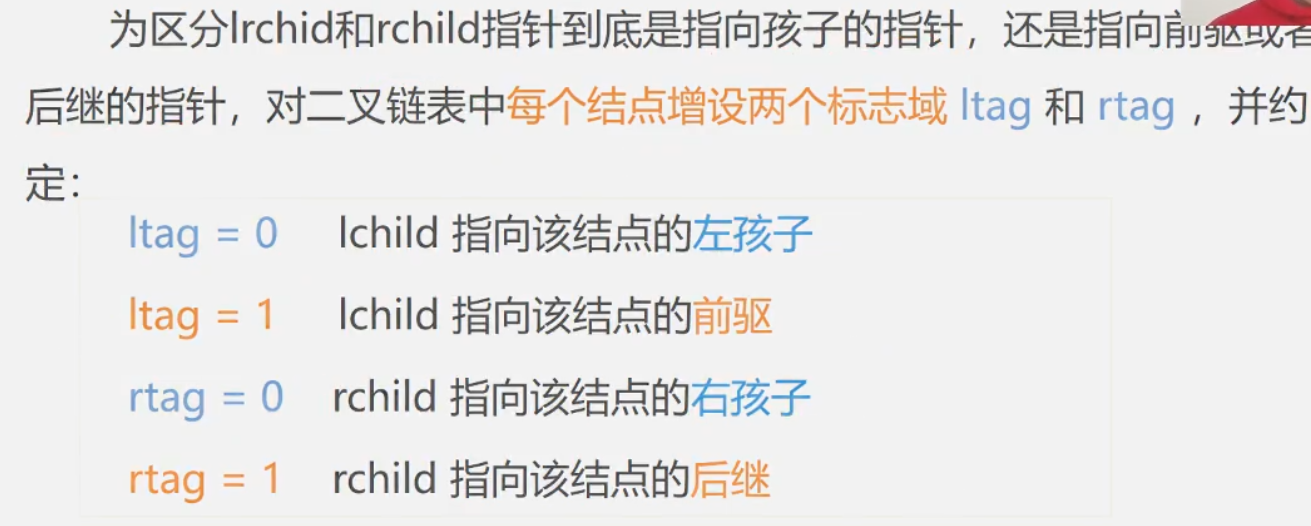
-
-
Node structure

typedef struct BiThrNode{ int data; int ltag,rtag; struct BiThrNode *lchild,*rchild; }BiThrNode, *BiThrTree;
Storage of clue binary tree
Preordered clue binary tree
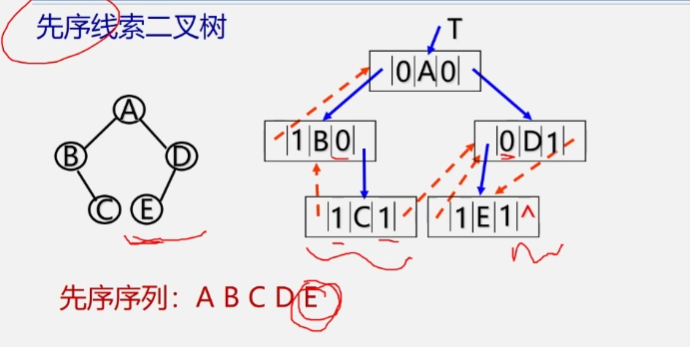
Middle order clue binary tree
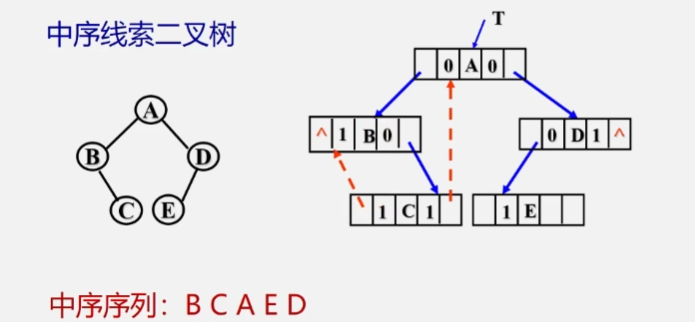
Post ordered clue binary tree

Add head node

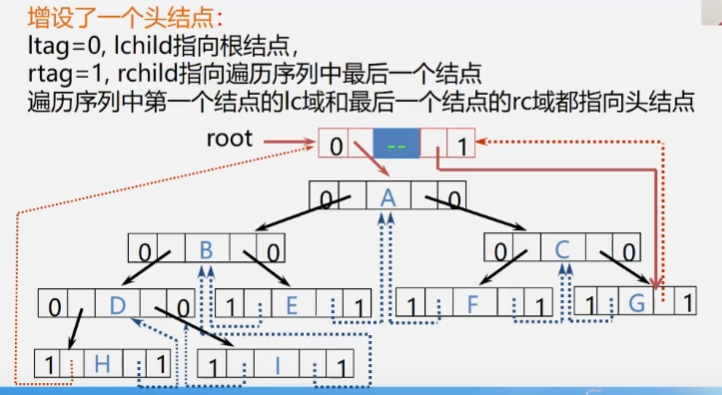
4, Trees and forests

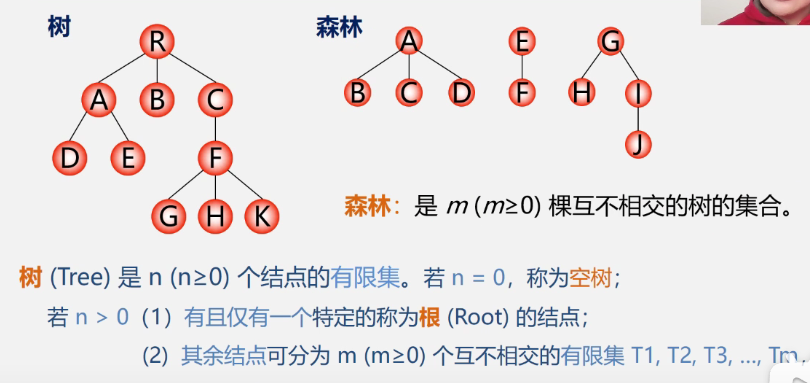
1. Storage structure of tree
Parental representation
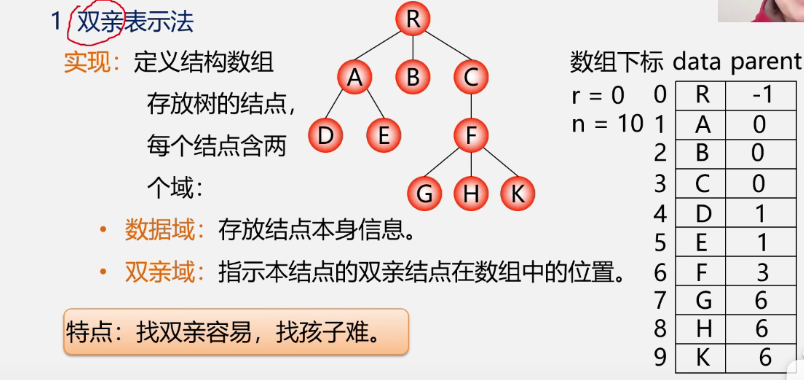
-
C language type description

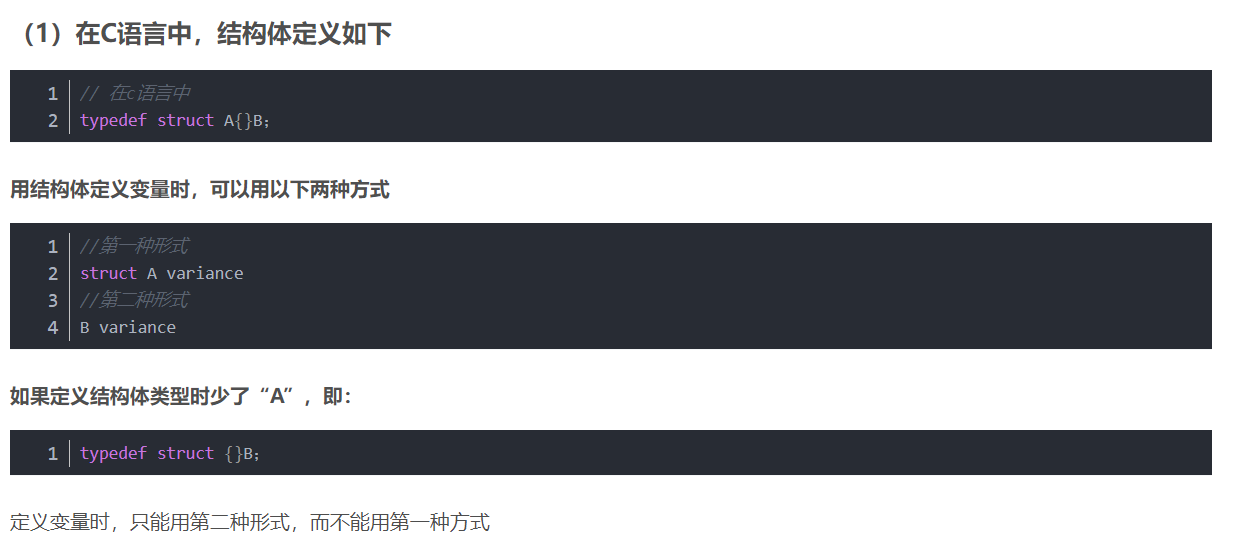
Child list

-
C language type description
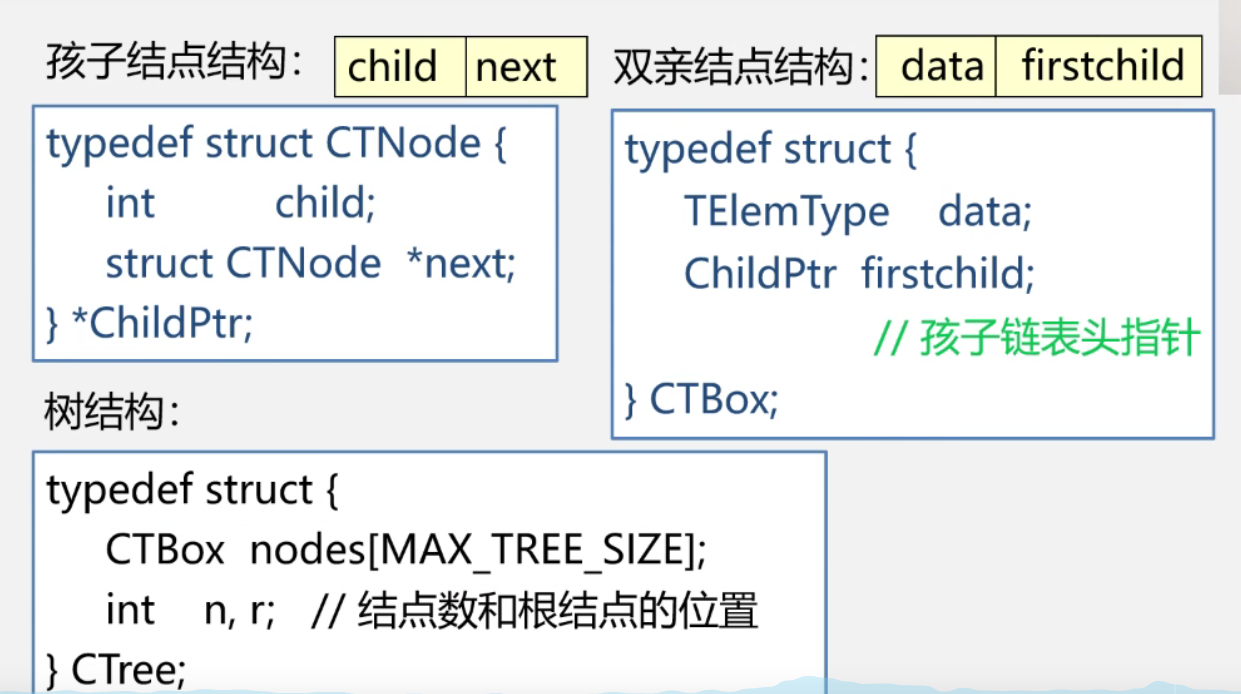
-
Add more data fields
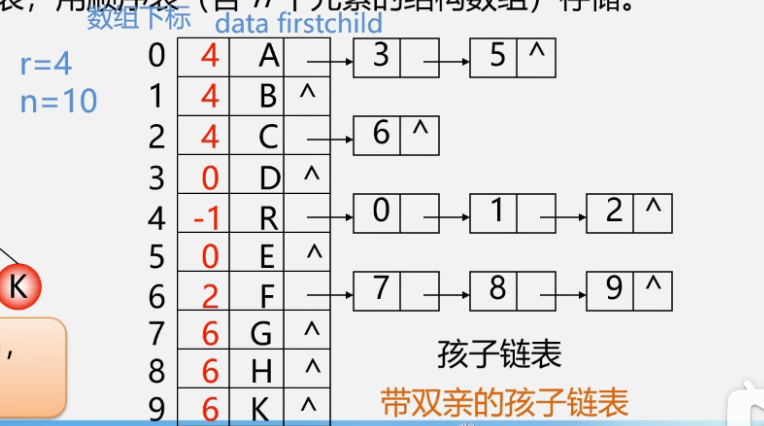
Child brother representation (binary tree representation, binary linked list representation)
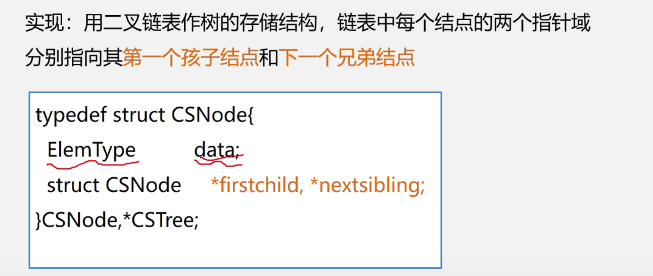
-
example
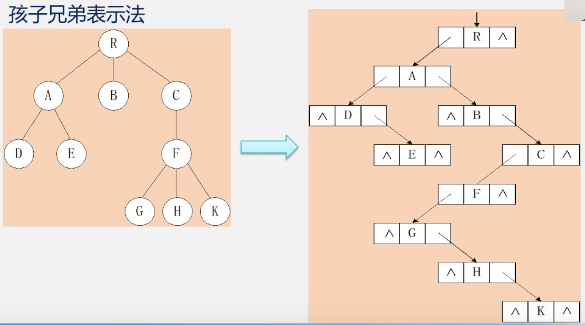
2. Transformation between tree and binary tree
Tree to binary tree

-
example

-
law

-
example
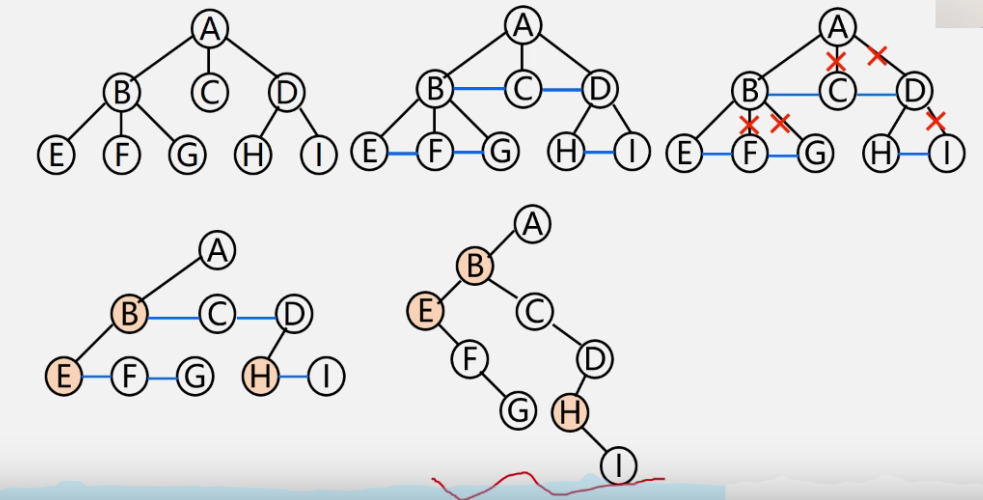
Binary tree to tree
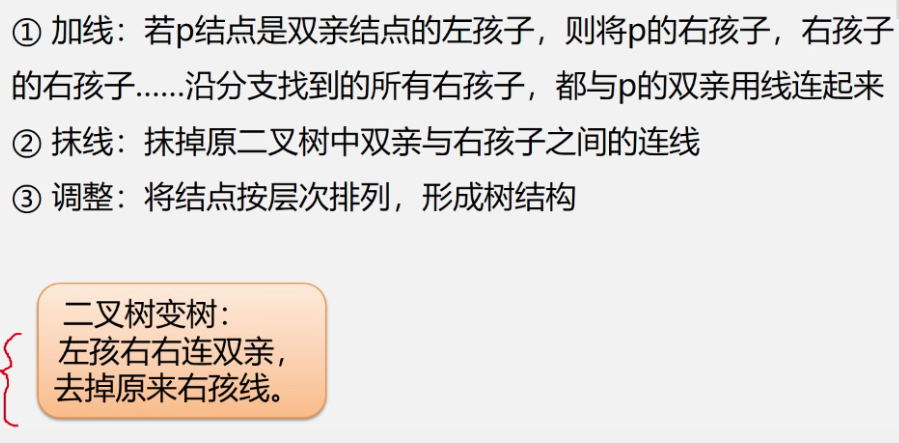
-
example
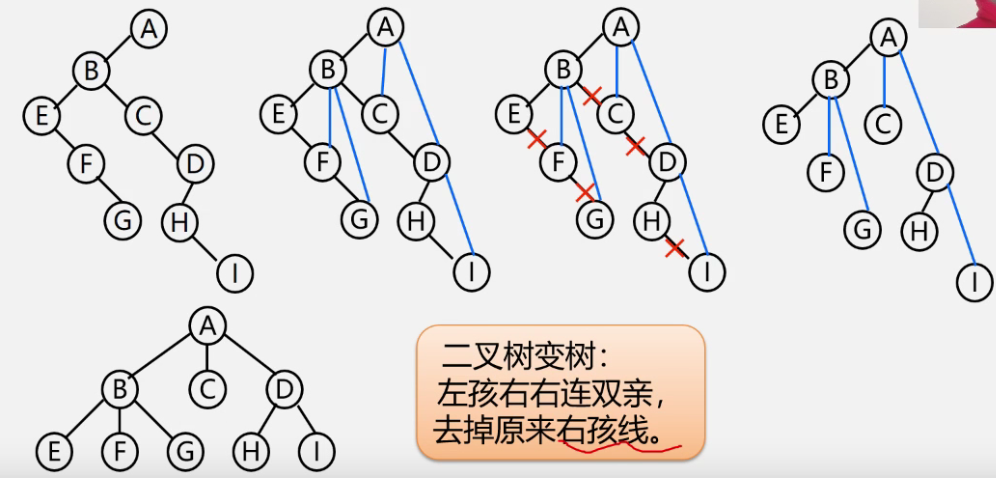
3. Transformation between forest and binary tree (relationship between binary tree and multiple trees)
Forest to binary tree
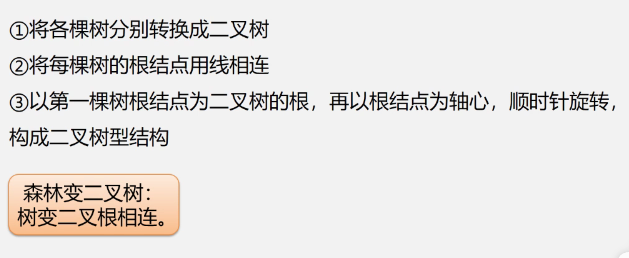
-
example
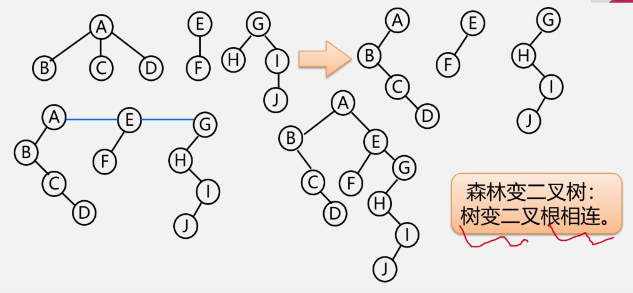
Binary tree into forest

-
example
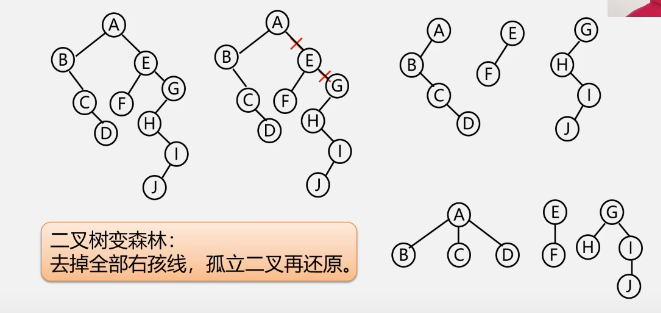
4. Traversal of trees and forests
Tree traversal (three ways)
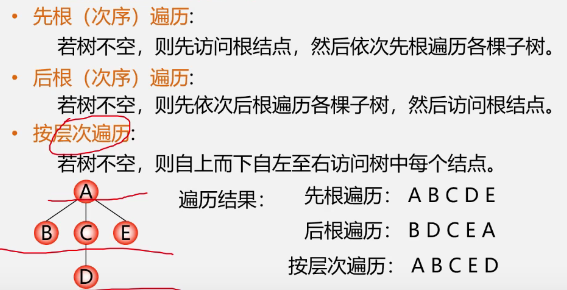
Forest traversal
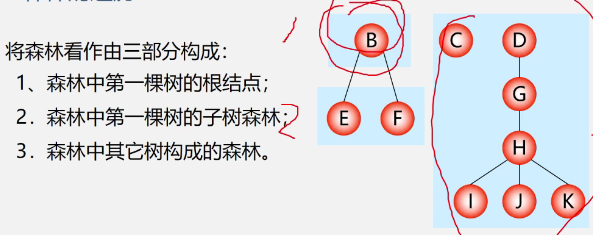
-
Preorder traversal
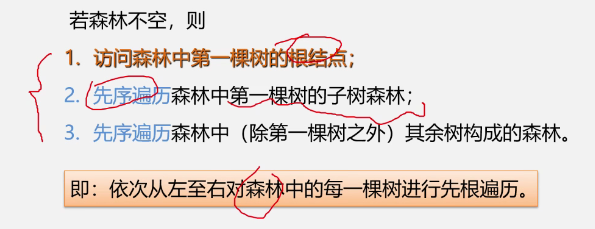
-
Medium order traversal
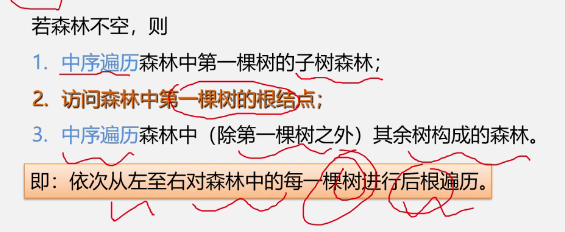
-
example
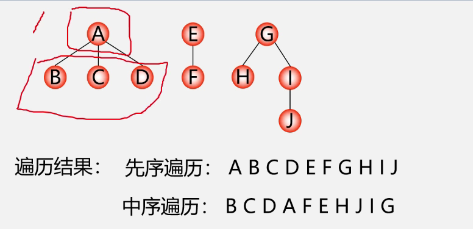
5, Huffman tree
1. Introduction
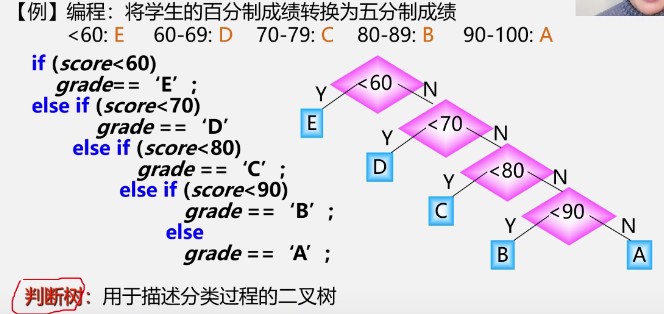

-
optimization
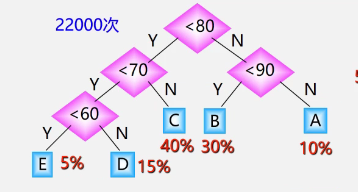

-
Huffman tree

2. Basic concepts
Path, path length, weight
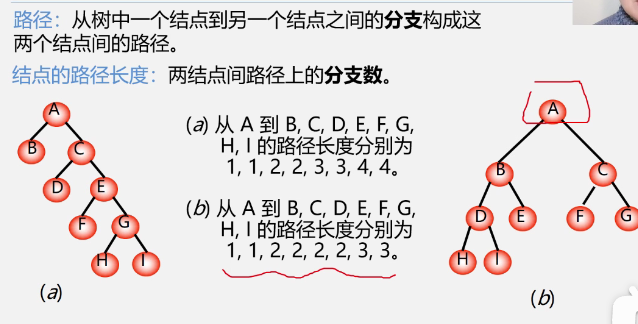
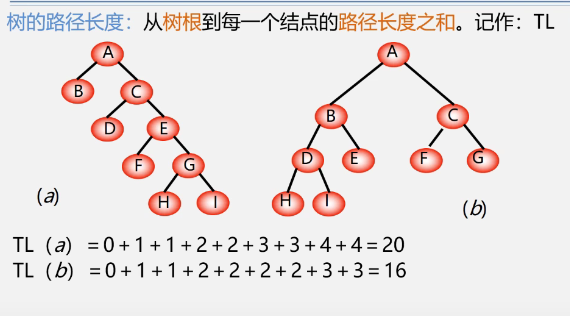
In the binary tree with the same number of nodes, the complete binary tree is the binary tree with the shortest path length
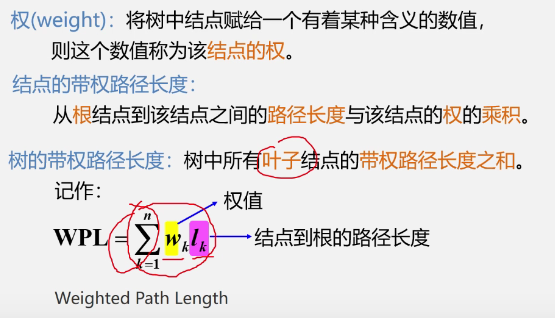
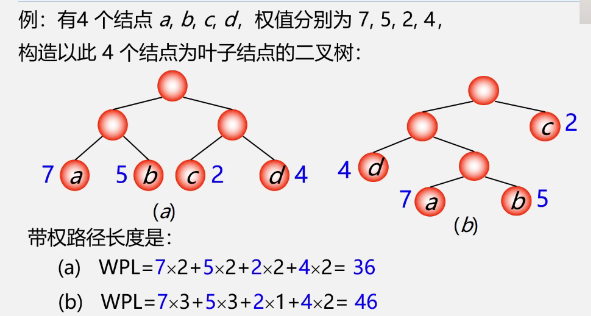
Huffman tree
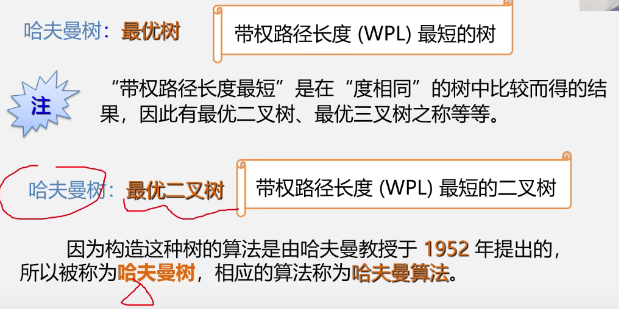
-
example

Characteristics of Huffman tree
- A full binary tree is not necessarily an optimal binary tree (Huffman tree)
- The more powerful the leaf in the Huffman tree, the closer it is to the root
- Huffman trees with the same weighted nodes are not unique
3. Construction algorithm of Huffman tree
-
C language implementation:
https://tyrantlucifer.com/44.html
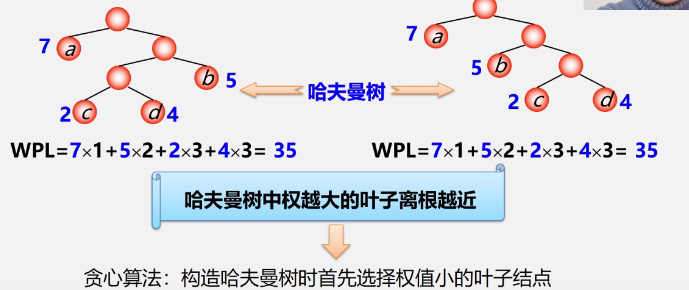
Huffman algorithm (method of constructing Huffman tree)
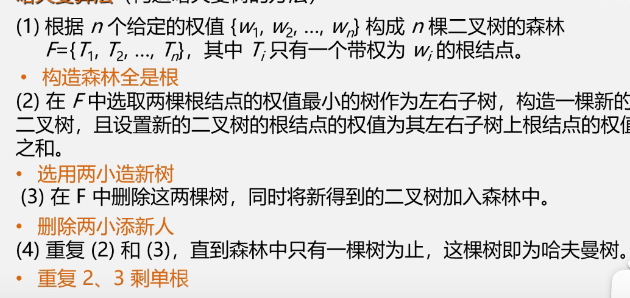
-
example


-
example

Characteristics of Huffman algorithm
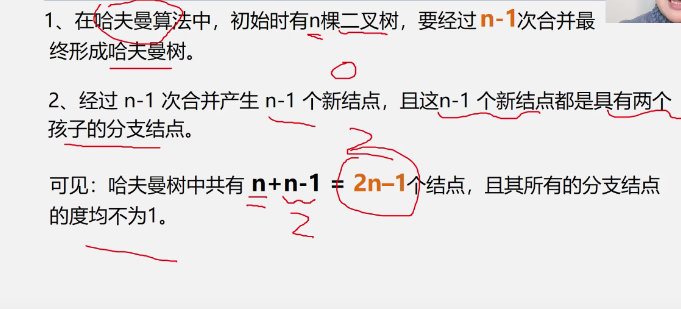
Implementation of Huffman tree construction algorithm
-
Sequential storage structure
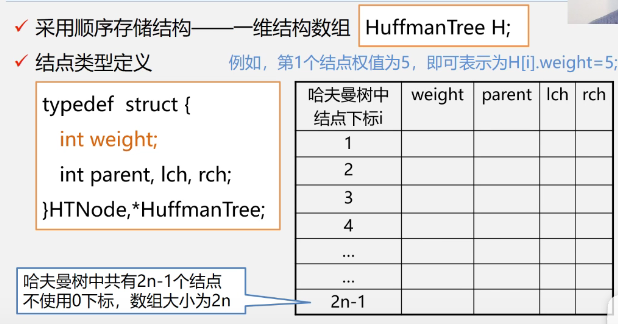
-
example

-
Algorithm implementation
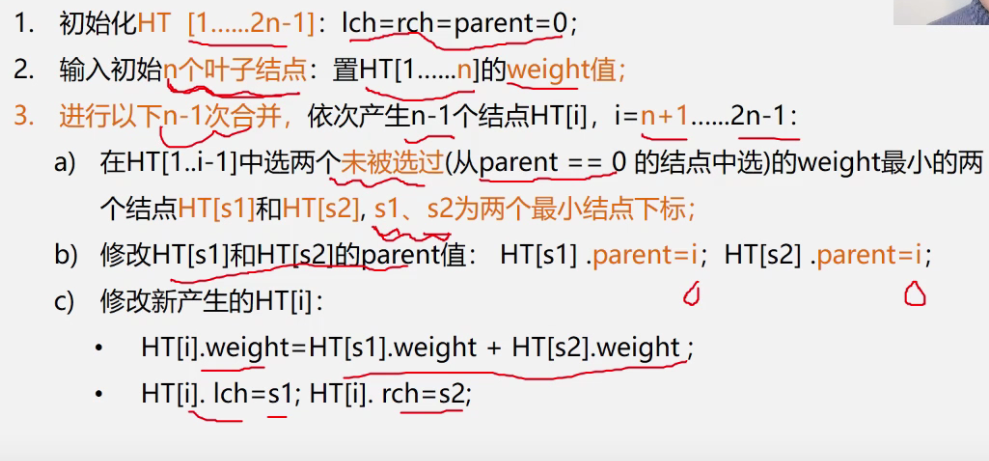
-
code implementation
void CreatHuffmanTree(HuffmanTree HT,int n){//Constructing Huffman tree -- Huffman algorithm if(n<=1) return; m=2*n-1; //The array has 2n-1 elements in total HT = new HTNode[m+1]; //Cell 0 is not used, HT[m] represents the root node for(i=1;i<=m;++i){ //Set lch, rch and parent of 2n-1 elements to 0 HT[i].lch=0; HT[i].rch=0; HT[i].parent=0; } for(i=1;i<=n;++i) cin>>HT[i].weight;//Enter the weight value of the first n elements //After initialization, let's start building Huffman tree for(i=n+1;i<=m;i++){ //Merging to produce n-1 nodes -- Constructing Huffman tree Select(HT,i-1,s1,s2); //In HT[k](1 ≤ K ≤ i-1), select two nodes whose parent domain is 0 and whose weight is the smallest, and return their sequence numbers s1 and s2 in HT HT[s1].parent=i; HT[s2].parent=i; //Indicates that S1 and S2 are deleted from F HT[i].lch=s1; HT[i].rch=s2; //S1 and S2 are the left and right children of i HT[i].weight=HT[s1].weight+HT[s2].weight; //The weight of i is the sum of the weight of left and right children } }
-
-
example

- initialization
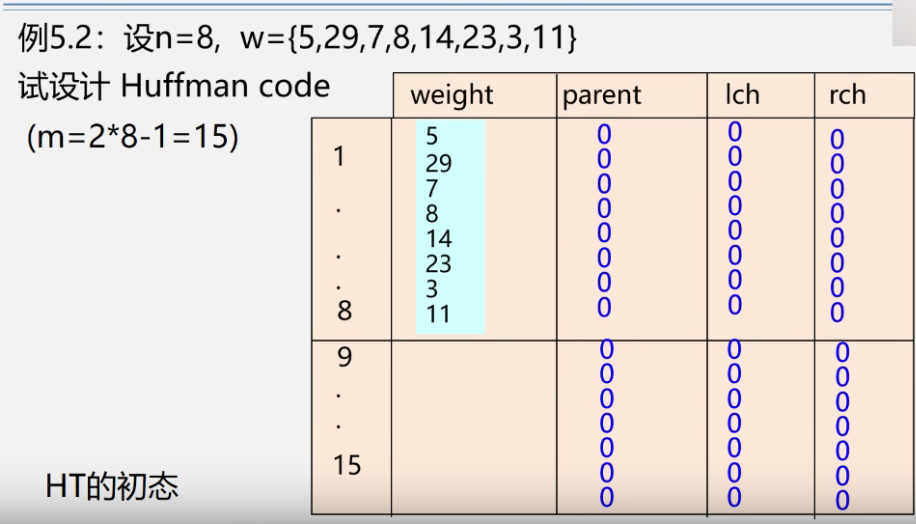
-
Constructing Huffman tree
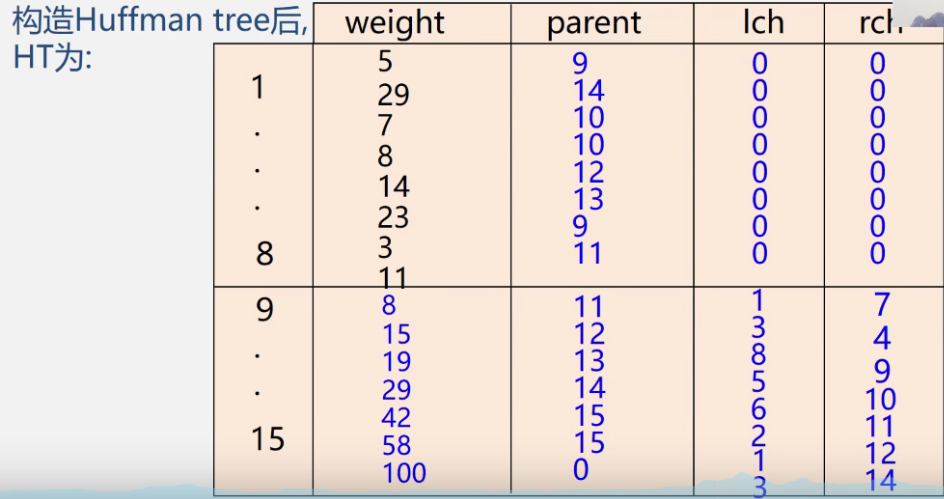
Application of Huffman tree -- Huffman coding
- introduce

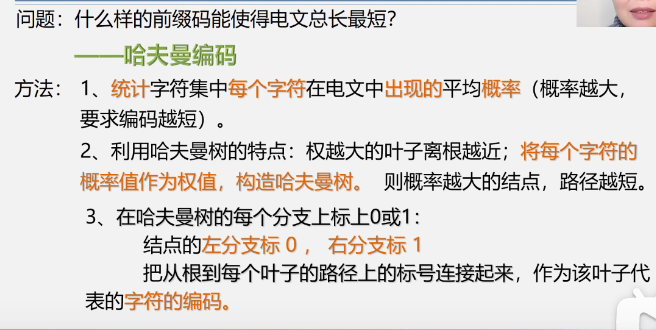
-
example
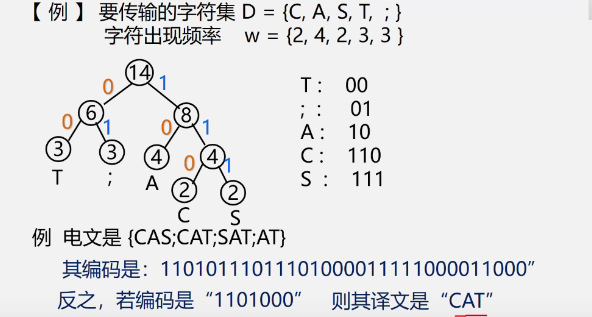
Properties of Huffman coding
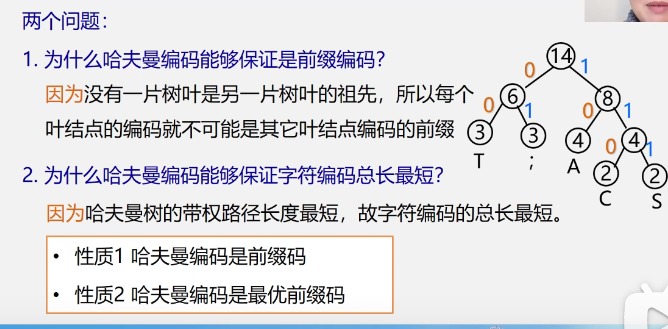
-
Example 54
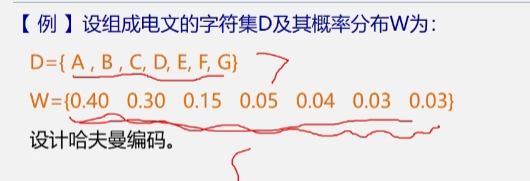
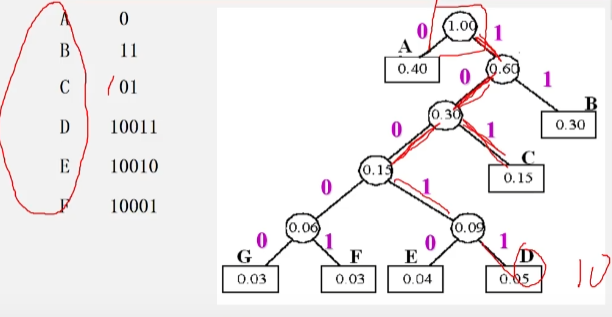
Implementation of Huffman coding algorithm
-
example
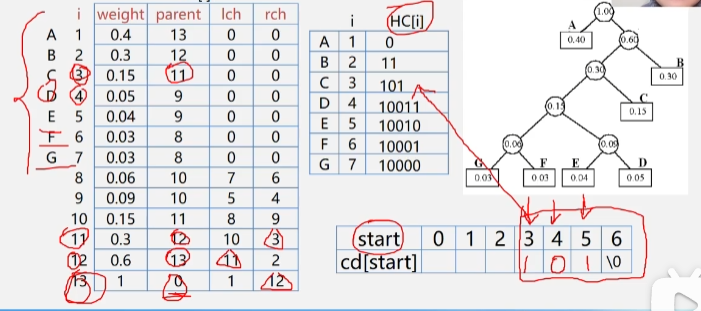
-
Algorithm description
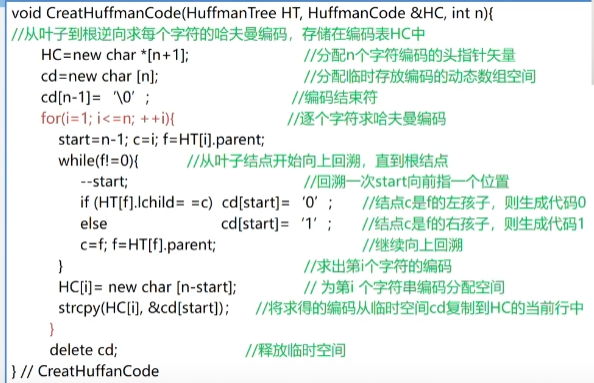
4. Application of Huffman tree
Encoding and decoding of files
-
introduce
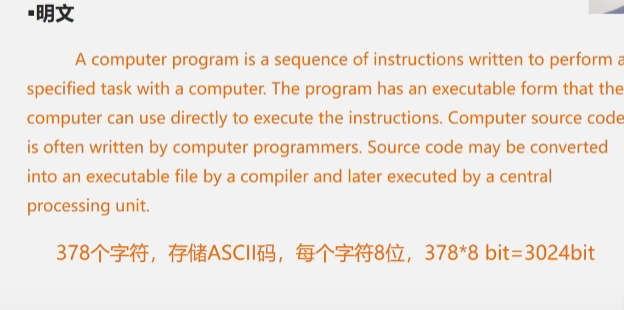
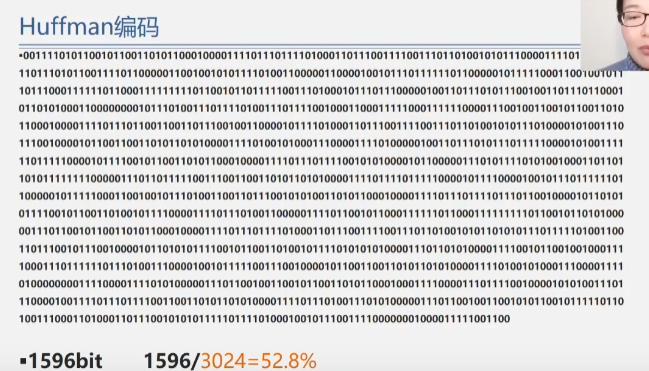
code


decode

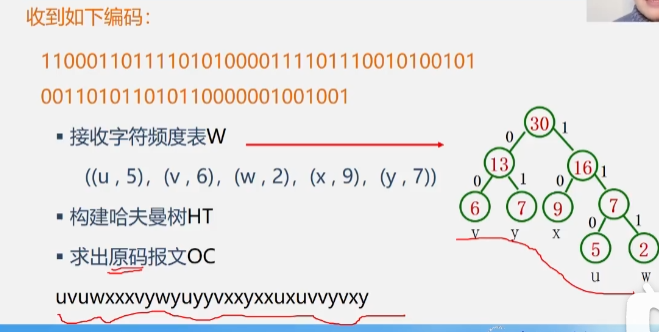
7, Partial code implementation
Solve the random code of vscode terminal: https://www.cnblogs.com/stu-jyj3621/p/12815080.html
The previous notes are pseudo code
Code implementation reference of this part:
Qingdao University MOOC: Data structure and algorithm practice
Great tutorial!
Supplementary review: C + + template, STL
#include <iostream>
#include <vector>
using namespace std;
//The vector vector is also a template
int main()
{
vector<int> v;
v.push_back(123);
v.push_back(4);
for (auto x : v) //For every element x in v
{
cout << x << endl;
}
cout << endl;
// return 0;
}
Episode: mentality burst
Tap the code into the tutorial and find that auto is wrong
I searched the expected primary expression before '}' token for a long time, but I couldn't find it. Another search method: VSCODE auto reported an error, and finally found it 😭 https://bbs.csdn.net/topics/392167864?page=1
 And found one https://blog.csdn.net/weixin_42292229/article/details/113767569
And found one https://blog.csdn.net/weixin_42292229/article/details/113767569
But the link above doesn't solve my problem
In order to solve the auto error report, toss for a long time
First solve it in dev:
-
The first reference: https://blog.csdn.net/u011500062/article/details/44628441 , the following error will be reported
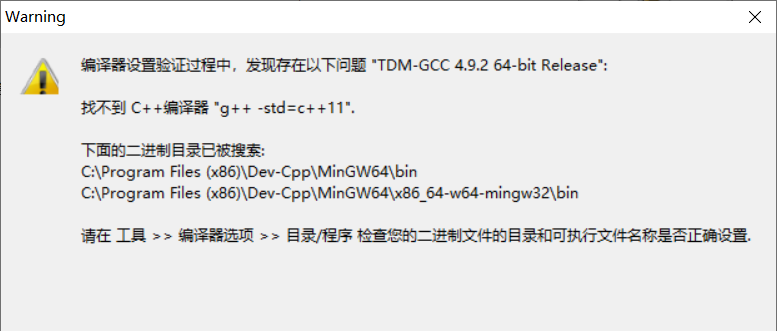
-
Finally solved this problem 😭
https://blog.csdn.net/Ljnoit/article/details/108153775
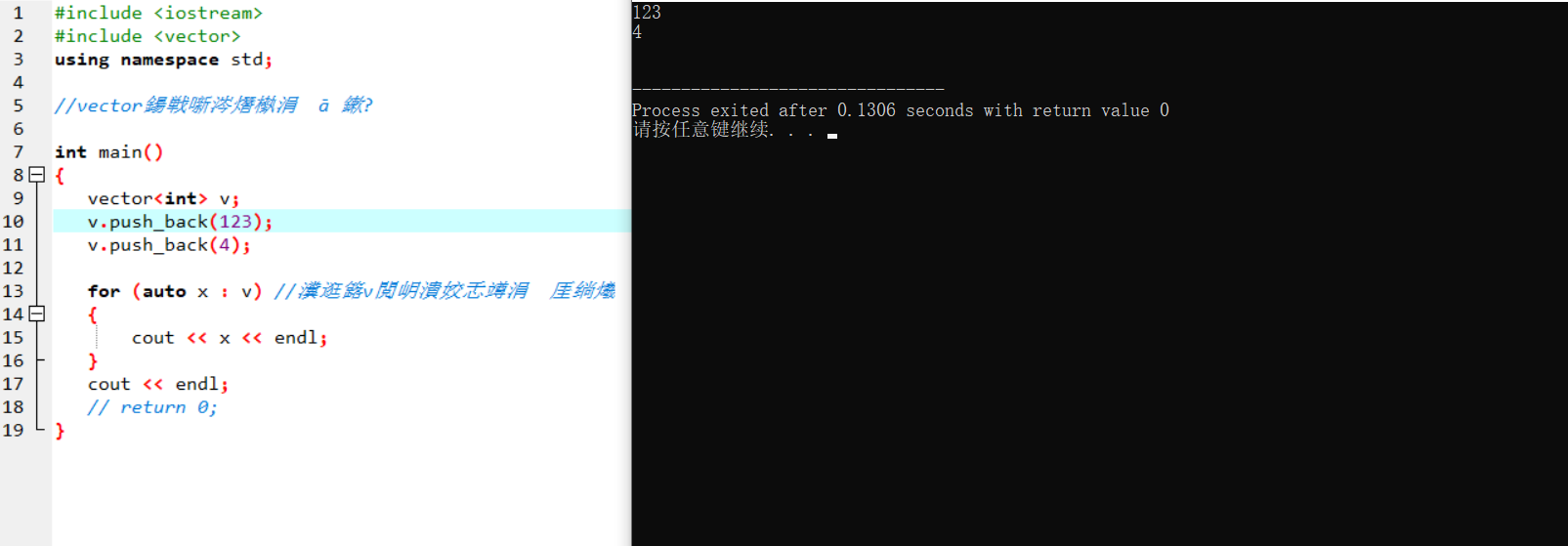
vscode... Gave up 😅😅😅… Checked for more than an hour
Searching the Internet for various methods is still useless

You can't change C++17 to 11 directly 😅

Use dev directly 😅
-
Press the object into the container
Create a class first
#include <iostream> #include <vector> using namespace std; //The vector vector is also a template class Stu{ private: string id; int score; public: //Construction method Stu(string id,int score){ this->id = id; this->score = score; } friend ostream& operator << (ostream &o,const Stu& s); }; ostream& operator << (ostream&o,const Stu& s){ o <<"("<<s.id<<","<<s.score<<")"; } int main() { Stu s("007",99); cout<<s<<endl; }
Object push into container
#include <iostream>
#include <vector>
using namespace std;
//The vector vector is also a template
class Stu{
private:
string id;
int score;
public:
//Construction method
Stu(string id,int score){
this->id = id;
this->score = score;
}
friend ostream& operator << (ostream &o,const Stu& s);
};
ostream& operator << (ostream&o,const Stu& s){
o <<"("<<s.id<<","<<s.score<<")";
}
int main()
{
// Stu s("007",99);
//
// cout<<s<<endl;
vector<Stu> v;
//First Stu s("007",99); Then v.push_back(s); This is equivalent to copying, which is a little inefficient
//It can be constructed in the container,
v.emplace_back("S007",99);
for(auto x:v)
{
cout<<x<<endl;
}
return 0;
}

Chain implementation of tree and binary tree (C + +)
Construction tree
#include <iostream>
using namespace std;
template <class Elem>
//typedef is C-style, and the template of C + + is used here
struct BinNode
{
Elem data;
BinNode<Elem> *left;
BinNode<Elem> *right;
//structure
BinNode(Elem x)
{
data = x;
left = right = NULL;
}
};
//Write a binary tree with a class template
template<class Elem>
class BinTree{
protected:
BinNode<Elem> *root;//Pointer to the root node
public:
BinTree() {root = NULL;}//Construct empty tree
BinTree(Elem r){
root = new BinNode<Elem>(r);//Construct root node
}
//Destructor
~BinTree() {
}
};
int main()
{
BinTree<int> bt(11);
return 0;
}
Traversal tree
- Preorder traversal
#include <iostream>
using namespace std;
template <class Elem>
//typedef is C-style, and the template of C + + is used here
struct BinNode
{
Elem data;
BinNode<Elem> *left;
BinNode<Elem> *right;
//structure
BinNode(Elem x)
{
data = x;
left = right = NULL;
}
};
//Write a binary tree with a class template
template<class Elem>
class BinTree{
protected:
BinNode<Elem> *root;//Pointer to the root node
void rpreprint(BinNode<Elem> *r)//Recursive print preorder traversal
{
if(r==NULL) return ;//Null pointer call returns immediately
cout<< r->data <<" ";
rpreprint(r->left);
rpreprint(r->right);
}
public:
BinTree() {root = NULL;}//Construct empty tree
BinTree(Elem r){
root = new BinNode<Elem>(r);//Construct root node
}
//Preorder traversal
void preprint(){
rpreprint(root);
cout << endl;
}
//Destructor
~BinTree() {
}
};
int main()
{
BinTree<int> bt(11);
bt.preprint();
return 0;
}
//structure
BinNode(Elem x)
{
data = x;
left = right = NULL;
}
};
//Write a binary tree with a class template
template
class BinTree{
protected:
BinNode *root;// Pointer to the root node
public:
BinTree() {root = NULL;} / / construct an empty tree
BinTree(Elem r){
root = new BinNode ®;// Construct root node
}
//Destructor
~BinTree() {
}
};
int main()
{
BinTree bt(11);
return 0;
}
#### Traversal tree
- Preorder traversal
~~~c
#include <iostream>
using namespace std;
template <class Elem>
//typedef is C-style, and the template of C + + is used here
struct BinNode
{
Elem data;
BinNode<Elem> *left;
BinNode<Elem> *right;
//structure
BinNode(Elem x)
{
data = x;
left = right = NULL;
}
};
//Write a binary tree with a class template
template<class Elem>
class BinTree{
protected:
BinNode<Elem> *root;//Pointer to the root node
void rpreprint(BinNode<Elem> *r)//Recursive print preorder traversal
{
if(r==NULL) return ;//Null pointer call returns immediately
cout<< r->data <<" ";
rpreprint(r->left);
rpreprint(r->right);
}
public:
BinTree() {root = NULL;}//Construct empty tree
BinTree(Elem r){
root = new BinNode<Elem>(r);//Construct root node
}
//Preorder traversal
void preprint(){
rpreprint(root);
cout << endl;
}
//Destructor
~BinTree() {
}
};
int main()
{
BinTree<int> bt(11);
bt.preprint();
return 0;
}